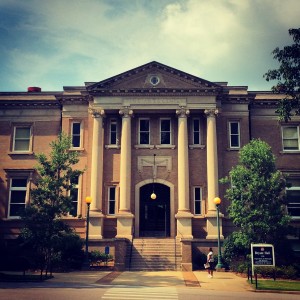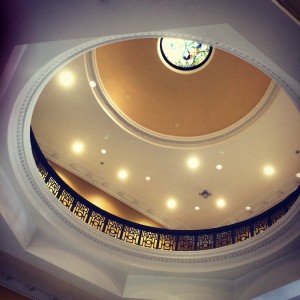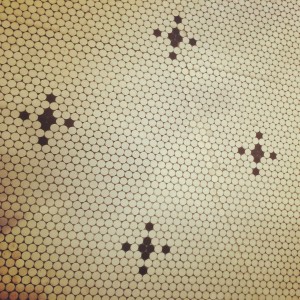Many Ole Miss students, alumni and fans have probably walked past the high steps leading to an impressive ironwork entrance at Bryant Hall and never thought to go inside. Until recently, I was one of those poor souls.
Readers of this blog may remember my cheesy, sentimental writing in a previous post about how the beauty of Ole Miss inspires me to Instagram it. Inspiration struck me again on a recent trip to Bryant Hall, so I went back to get some photos to post to my profile.
The sort of imposing building just west of the Student Union on the edge of the Lyceum Circle is one I don’t remember ever entering when I was a student here (Class of 2005). But I went there recently to interview someone for a story and after strolling around for a few minutes, I decided Bryant Hall is one of my favorite places on this beautiful campus.
Though the towering, stately-looking front of Bryant Hall is kind of uninviting; the inside is a complete contrast to the feeling the outside gives you. There’s something about the quiet, cool, calm atmosphere there during summer that puts one completely at ease. On a recent day there, in the sprawling lounge area with comfy leather couches, I saw someone stretched out taking an afternoon nap. That’s not a usual thing for a college kid to do, sure, but the slumbering person was actually a grown man.

The globe in the center of Bryant Hall, which is 6 feet in diameter, moves with the rotation of the Earth. Photo by Michael Newsom.
In the center of the building, there’s a globe, which is an impressive 6 feet in diameter. Those who pass it probably don’t realize the globe actually moves very slowly, mimicking the rotation of the Earth. It was designed by Todd Ulrich, president of Cincinnati-based Worldfx Inc., which provides state-of-the-art, real-world visualizations of the Earth using satellite imagery. It took nine months to build.
“This is the largest, most detailed globe in the world employing state-of-the-art satellite data and cartography enabled by GIS software,” Ulrich told University Communications in 2007 upon the completion of the building’s renovation, which included the new globe.
Bryant Hall was built in 1911 and originally was home to the UM library and also the medical school library, University Museum, some reading rooms and also some faculty offices. One year, after it opened, gym equipment was installed and the basement area became the “women’s gym.” Today, the building doesn’t feel nearly big enough for all that, but the cozy feeling of the entrance area plays tricks on your perception. Only when you look up toward the impressive rotunda dome do you get a sense of how large the building really is.
It became home to the speech, theatre and art departments when it was dubbed “the Fine Arts” building in 1951. The speech and theater departments were moved and in 1984, the building was named for Vice Chancellor Emeritus W. Alton Bryant, who served as chair of the UM Department of English from 1947 to 1953, then later became the university’s vice chancellor.
In 2006-2007, the building underwent a heavy renovation. After the work was complete, the departments of philosophy and religion and classics were moved there.
Once the renovations were complete in 2007, Molly Pasco-Pranger, an associate professor and chair of the classics department, toured the finished product. She said recently she remembers that her “jaw dropped.”
“I was so excited for our two departments to share this beautiful space, and it has been a pleasure to work in for the last seven years,” Pasco-Pranger said. “We have wonderful offices and classrooms, of course, but we’ve also made great use of the Farrington Gallery on the main floor as community space for our majors and other students. We hold informal talks and round tables there, host honor society initiations and public readings,and regularly set out Friday classics lunches and study break snacks during exams.”
She said it seems more people are taking notice of the building’s charm, too.
“Gradually, word has gotten round about this jewel of a building,” she said. “It’s in constant use by students for quiet study space, and it is now not unusual to find the gallery and classrooms booked for events and meetings several evenings a week.”
The building is indeed full of well thought-out architectural details that contribute in their own ways to the beauty of the building. One aspect that drew my attention is the tiny tiles on the floor, each of which looks to be about the size of a penny. As someone who owns a home and has taken on a few projects, I can vouch for the fact that a lot of care and skill went into getting those tiles right.
The building doesn’t get as much attention and adoration as some of the other beautiful, more iconic parts of campus, such as the Lyceum, the Grove and the Quad. Those who do visit it encounter the small, charming architectural details working together with the more impressive large parts of the building, such as the globe and the ironwork entrance. The collective effect of all those details is a building that easily wins you over. I’m not the only one who thinks this.
UM Assistant Professor of Classics Hilary Becker said when she first came to Ole Miss in the fall of 2012, the building, and especially the globe, made an immediate impression.
“The first time I entered Bryant Hall, I was struck by the rotunda and that amazing rotating globe,” Becker said. “As a classicist, the liberal arts and humanities are really about human connectivity. And for me, having the globe in the same building as my department reminds me that sometimes in terms of the vastness of the world that it really is a small space.”
Indeed. The world is so small, but also beautiful, especially this part of it we call Ole Miss.




